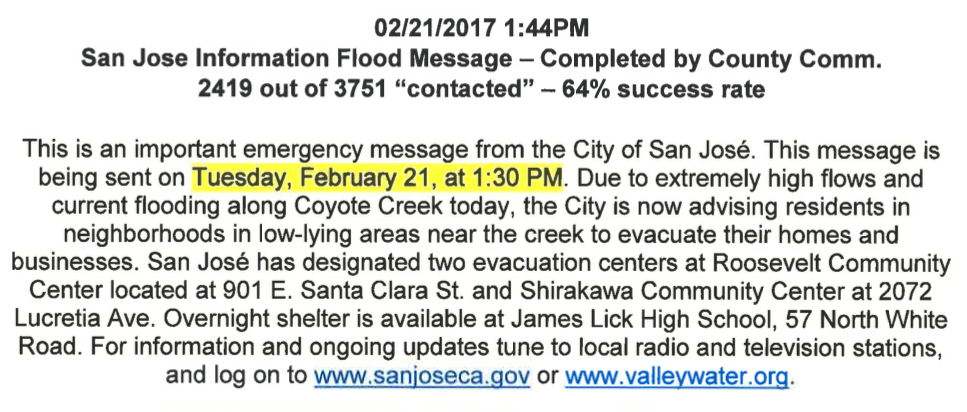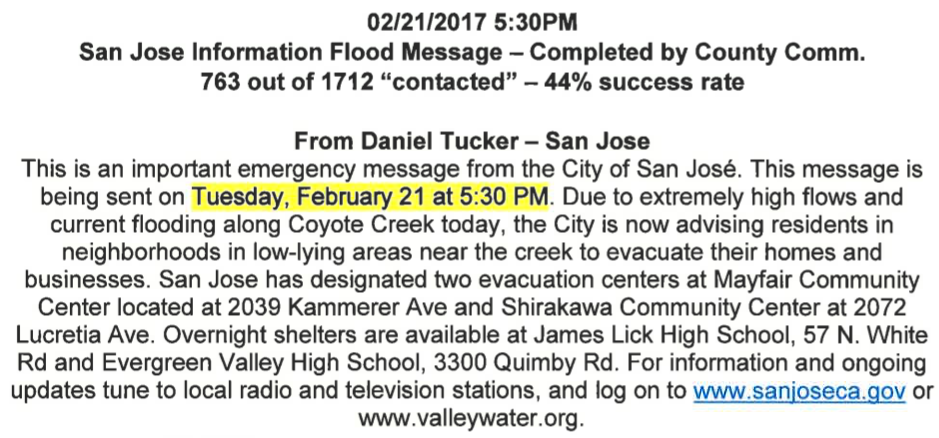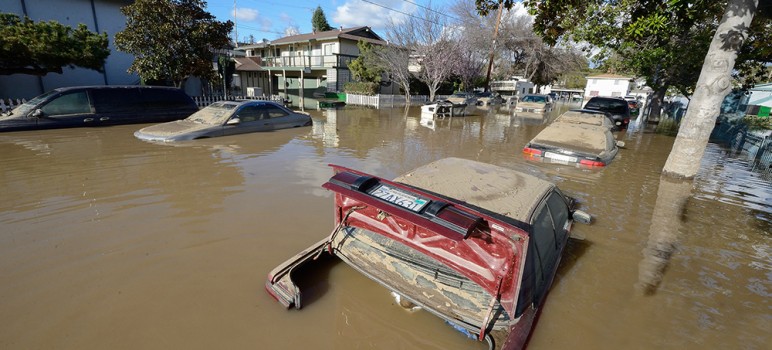Since the flood that submerged hundreds of homes and businesses in San Jose last week, people have been asking what took the city so long to sound the alarm. The first calls for evacuation came several hours after entire neighborhoods were underwater.
But there’s another still-lingering question: how many people in mandatory evacuation zones actually got the order to pack up and leave?
A memo released by Santa Clara County earlier this week answers that question and sheds more light on the inter-agency communications—specifically 26 calls over the course of several days leading up to the Feb. 21 and 22 flood and a couple days after. The document, signed by county Executive Jeff Smith, lists each warning sent on the regional AlertSCC app, which dials phone numbers of people in the affected areas.
The county sent AlertSCC warnings to 19,808 phones over the course of two days during the flooding. According to the city, mandatory evacuation orders accounted for 14,000 of those calls. But not all of those alerts made it to their intended recipients.
.@jennwadsworth @Josh_Koehn Can you push to confirm how many of the 14K were actually notified directly to evacuate? @metronewspaper
— (((Jaime Fearer))) (@bogrosemary) March 2, 2017
Though the county manages AlertSCC, each city in the region is responsible for publicizing the online portal for people to sign up for it. Each city is then responsible for using AlertSCC to notify people in their respective jurisdictions of impending danger. The county is only in charge of warning people in unincorporated areas. The National Weather Service (NWS) uses its own alert system, which crosses local jurisdictions.
In fact, long before the county or the city sent any notice on AlertSCC, the NWS put out a flood warning for Coyote Creek. That alert was in effect by 8:30am Feb. 20, a full day before the flooding, and it cautioned people in south San Jose’s Edenvale neighborhoods to prepare for the rising waters.
In a phone call the morning of Feb. 20, the NWS told officials from the Santa Clara Valley Water District, the county and the city that its flood warning was in effect and rainfall would continue for the next 12 hours. The water district told officials in that same call that four reservoirs were spilling by that point: Anderson, Uvas, Lexington and Coyote. The city told the others on that call that it had activated emergency operations centers, was monitoring the streams and was prepared for debris cleanup.
About seven hours later, at 3pm on the day before the flood, the NWS told those agencies in another call that it had expanded its flood warning for all of Coyote Creek. The water district said its four reservoirs kept spilling and the city said it already had to rescue two “urban campers” and opened a couple evacuation centers.

The county issued its first emergency notice, an AlertSCC flood warning, at 8:14pm on Feb. 20—the night before the Coyote Creek jumped its banks and began flooding the city. That warning was sent to 282 people in the unincorporated Ross area, which lies at the intersection of highways 85 and 87. Some 73 percent of those people were actually contacted, according to the county. The rest of those alerts went to voicemail or were otherwise unsuccessful.
The county sent out a second alert a little more than an hour later, at 9:20pm Feb. 20. This one was a mudslide warning, which was sent to 527 people. Seventy-four percent of them received the call.
Early the next morning, Feb. 21, Coyote Creek began flooding. By 7am, rescuers had to save several homeless people stranded in the trees by Los Lagos Golf Course. Yet still, the city didn’t issue an alert.
Two hours later, in a 9am inter-agency phone call, the NWS said it had extended its flood warning to the Madrone area. The water district said that seven reservoirs were spilling. The city reported: “The Rock Springs neighborhood is flooded … will be issuing messaging along Coyote Creek.”

One of the call summaries listed on the county memo marks the wrong time, city spokesman David Vossbrink noted. A call about an evacuation marked as taking place at midnight Tuesday actually happened at 10am that day, he said.
“Probably a cut and paste error,” Vossbrink said, “but it means you have to be careful with the info from the county. That’s a big discrepancy.”
County spokeswoman Laurel Anderson said that was a mistake and issued a revised document to reflect that correction.
In that 10am Feb. 21 call, the city said it had put the Rock Springs area under forced evacuation. By then, however, hundreds of people near Needles Drive and Nordale Avenue already had to be rescued because they received no warning. The “messaging” issued by the city wasn’t sent out on AlertSCC, apparently, but on social media and by email—little of which reached the predominantly Vietnamese and Spanish-speaking residents of Rock Springs.

Note: Correct time was 10am on Feb. 21.
In a conference call that morning, the city said it proclaimed evacuations in that area and transported people to James Lick High School, one of two overnight shelters. However, according to the county, the city had yet to issue any notice on AlertSCC.
At 1:44pm Feb. 21—about seven hours after the flood rescues began—the city asked the county to send out an AlertSCC warning on its behalf. That warning was sent to 3,751 people, but only 2,419 of them (64 percent) received it.

The next listed conference call began at 3pm Feb. 21. The NWS said Coyote Creek wouldn’t fall below flood levels until the following day. The water district said the flooding would reach Charcot Avenue within about five hours. And the city said it had set up a command center at the Golden Wheel Mobile Home Park and began distributing flyers to pass out in potential flood areas.

At 5:30pm that same day, the city asked the county to issue another AlertSCC warning. This one was sent to 1,712 people in North Valley, but only 44 percent of them received it.

Another mandatory evacuation alert went out at 9:23pm Feb. 21 to 229 people in Naglee Park. Sixty-eight percent of them received it. At 10:25pm, AlertSCC advised 5,221 people north of I-280 and south of I-237 along Coyote Creek to leave their homes. Only 58 percent of them got the message, which was sent in both Spanish and English.
A few other alerts were issued throughout that night and early next morning. In a couple of those cases, the calls came about 40 minutes after the evacuation advisories were ordered. It’s unclear what caused the delay.
The city has yet to answer why it relied so much on the county to notify residents about the flood. San Jose has full access to AlertSCC and bears the legal responsibility of warning people who live within the city about imminent threats.
What’s also unclear is why each agency seemed to have a different standard for when to issue evacuation advisories and flood alerts. The city has said it relied on the water district’s projections that flooding would occur at a certain flow rate, which were wildly off base. But the NWS apparently had another standard for sounding the alarm.
Meanwhile, the city will hold a public hearing on the flood at 3pm March 9 to talk about some of those issues and give residents a chance to air their concerns.
“As we continue the recovery and relief effort, we must also begin to better understand and evaluate exactly what happened in the days leading up to during and following the flooding,” Mayor Sam Liccardo wrote in a memo co-signed by Vice Mayor Magdalena Carrasco and council members Raul Peralez, Lan Diep and Tam Nguyen. “This is the only way to identify and fix some of the shortfalls in our preparation and response, and to better protect our residents from floods.”
In his memo for the March 9 meeting, Liccardo said he wants the city to drum up a plan for how to improve communication with other agencies. He also wants to come up with more “low-tech” emergency notifications, including knocking on doors and rallying trained civilian “block captains” to spread the word to neighbors.
The mayor also suggests working with the county Office of Emergency Services to improve early warning systems the city could use to notify residents about looming threats, whether or not they subscribe to AlertSCC.
Liccardo said he wants to talk about the false data from the water district about the river capacity and projected timing, which, he said, “in retrospect, should have triggered more aggressive and specific warnings to residents.”
At the meeting next week, the city also plans to discuss the possibility of building a levee along the Rock Springs neighborhood, as well as ask the water district about the status of flood protection projects already approved by voters in past bond measures.
San Jose has set up a landing page for information about the flood, available here.
Click here to view the county’s version.
Both the county and the city have declared states of emergency, which qualifies local agencies for state and, potentially, federal disaster aid.



That’s Wonderful,
Now please investigate why these creeks and rivers were not cleared of trees, dead trees, brush, homeless camps and other refuse, that we have been taxed on over and over again since 1997 the last time we had major flooding here!
Where did the money go?
Last summer the Guadalupe near Park Ave was cleared of large debris and big rocks. It didn’t overflow (other than the bicycle trail). If debris wasn’t removed at all from each of them periodically, we’d have ALL been waist deep.
it goes into the district 500 million portfolio, money is moved to pet projects, other money used for a new boardroom which if anyone was watching they approved last year that will run they say 500k but with all the district time, overruns, buy time its done cost will be over 3 million just so you can watch the tax robbers all 75 ppl in HD and 4k video. go through old san jose inside articles and you will see links etc.
THE DISTRICT WILL NEVER CHANGE ALL SMOKE AND MIRRORS, TAX MORE TAX READ THE AUDIT 2012 https://pgoeltz.files.wordpress.com/2014/06/diversityaudit2012.pdf IT EXPLAINS THE DISTRICT managers and why employees distrust them. which is why there is no function at the top. ask why a 3rd boardroom was approved. ask for that DA audit, open the books. If you watched the meeting last nite, pretty much talk talk talk, oh we are humble. the chair says.
Dear Mayor Sham Lie-hard-doh:
Flooding was *expected* due to uncontrolled overflow at Anderson. This was widely known and verified by email(s) from the SCVWD. Only the exact timing and locations were in question, as the low lying areas and locations known to flood previously have been well documented.
You and your Administration knew well and good which (less than 5) neighborhoods were most at risk. It was your call to decide when and where evacuations would be made, and… failure resulted. You first blamed the SJFD, understaffed and unsupported as a result of your Measure B campaign.
How well do you think the response will be to an *unexpected* disaster, like an earthquake or large fire like Santana Row? SJPD and SJFD are woefully understaffed and their Computer Aided Dispatch systems barely run under normal conditions. With increased workload during a disaster and no cell tower communication… it will be beyond pathetic. But, we all recall you telling us how San Jose will be more efficient and better once you’re elected- because of your commitment to technology. I believe it was an e-mail to you and your staff that was ignored, warning of the immediate floods that you ignored. How well do you really grasp technology? Now it seems you want a low tech plan, like knocking doors.
Taxpayers were promised Transparency… Diversity… Fiscal responsibility all through use of technology. It was in the book you published. What we have received in your first term is incompetency. You have accomplished zero campaign promises.
I could see on the faces of those being rescued by boat that they were eternally grateful for your progress on Transparency, Diversity and the marvelous success you’ve had with creating revenue for the City (Wait, what… Another deficit is expected?). We won’t get into how you promised to support Measure B, vetting of Uber/Lyft drivers or regulation of marijuana dispensaries and card clubs- then abandoned those promises after you were elected.
We see that again and again the media endorsed candidates of this newspaper (looking at you SJI, Josh and Jennifer) are detrimental to our community.
When will taxpayers hold you to your promises and failures?
Don’t speak on behalf of those being rescued by boat to score some political points. All three agencies failed.